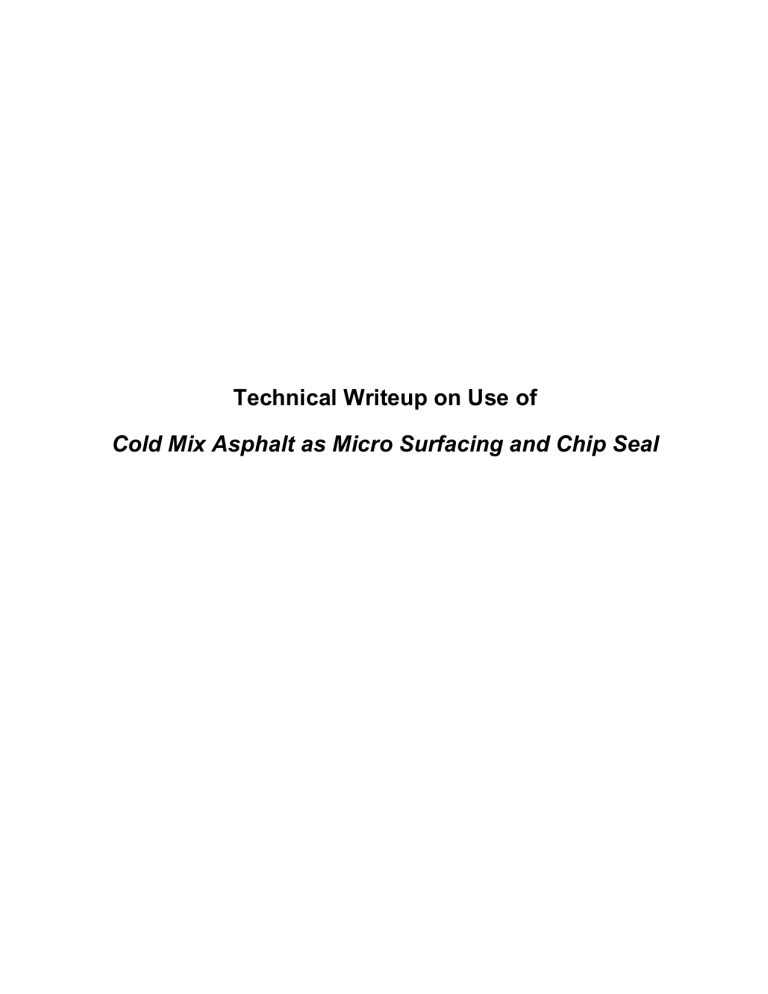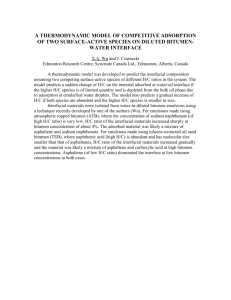Technical write up on Chip Seal and Fog Seal Asphalt Pavement Technology
advertisement

Technical Writeup on Use of Cold Mix Asphalt as Micro Surfacing and Chip Seal 1. BACKGROUND Worldwide road traffic is steadily increasing. The regulations additionally allow higher axle loads for trucks and higher speed for the cars. The Climatic conditions around the world are rapidly changing and the ambient temperatures are also rising. As a result, distress and related damages for road surfaces have been widely observed. On the other hand, the government funding for road repairs is generally limited. These trends demand superior road pavements with a higher ability to carry loads and with longer intervals between maintenance and reconstruction work. These requirements cannot be achieved by conventional asphalt technologies. It is necessary to increase the high-performance bituminous binders and mixtures, to modify the binders and to use the bitumen emulsion technology and their application as cold mix asphalt, chip seal, Slurry seal and Micro surfacing. New asphalt technologies such as Micro Surfacing, Slurry Seal, Chip Seal or Polymer modified Asphalt have been developed and executed worldwide, which is also an area of our expertise. The most common problems faced by the asphalt industry are cracking, raveling and rutting. Such problems reveal themselves within a short time span of the asphalt pavement. It causes a higher maintenance cost and impact on the budgets of the roads and highways. Additionally, any road with poor performance endangers the drivers and causes road traffic accidents. The asphalt industry, through years of research, has come up with many ways to increase the quality of asphalt pavement and reduce the initial cost and maintenance cost. This necessitates the need for a new asphalt pavement strategy with a target to extend the life of the pavements. A new formulation for the asphalt pavement is essential for the construction industry. The quality of aggregates, its characteristics, size, type, the bitumen source, bitumen quality, the amount of bitumen in the mixture, type of additives, the quality of bitumen emulsion, the technical knowledge of staff and the quality of machineries used are the most important factors for a good pavement. 2. BITUMEN Bitumen is a highly viscous black liquid derived from a low grade of crude oil. It is a widely used construction material and, in some countries, bitumen is also referred to as Asphalt. In some other countries Asphalt means a mix between Bitumen and aggregates. Bitumen comes from 3 different sources. • Bitumen can be produced through the distillation of crude oil. • Bitumen as Natural bitumen can be found as deposits in bitumen lakes. Bitumen deposits occur naturally at the bottom of lakes, where prehistoric organisms have decayed and been subjected to heat and pressure. • Bitumen obtained by destructive distillation of coal, wood or other materials. It is different from bitumen and is classified as coal Tar, Wood Tar and Mineral Tar. Tar is a high viscous liquid which contains a high amount of Polycyclic Aromatic compound and Polycyclic Phenol compound. Therefore Tar is a carcinogen Material and should not be used as construction material. • Bitumen is known for its waterproofing and adhesive properties and is commonly used in the construction industry. Bitumen can be applied in different forms such as Cutback Bitumen, Plastic Bitumen, Blown Bitumen, Straight Run Bitumen and Bitumen Emulsion • Bitumen can also be made in its own production factory from the residue of the oil distillation process (Vacuum Bottoms, VB). • Different kinds of bitumen can be locally produced and applied as binder. The transportation cost will significantly reduce and it creates employment opportunities for locals to work in a bitumen production factory. The bitumen can be used for Hot Mixture Asphalt, Bitumen Emulsion and in the roofing industry as isolation material. 3. BITUMEN EMULSION Bitumen emulsion is a mixture between water and Bitumen. The bitumen is an oil product. Bitumen is a viscous substance that exists in a liquid to a semi-solid phase. For bitumen emulsion production, the bitumen cannot mix with water. Bitumen has a high viscosity at room temperature. The water can be mixed with Bitumen with the help of an Emulsifier. Emulsifiers are surface active agents that keep the bitumen in its fine droplet state by disallowing it to mix with other droplets. As the droplets are very fine they suspend in water. Therefore, bitumen emulsion is a dispersed liquid consisting of three products, i.e. water, bitumen and emulsifier. The Bitumen Emulsions are classified by their ionic charge. It is either cationic or anionic. Since water bitumen emulsions are used intensively as binding and film-forming material in construction, two types of emulsion are used: anionic and cationic. Cationic emulsions begin with a “C” If there is no C, the emulsion is usually anionic. The charge is important when designing an emulsion for compatibility with certain aggregates. 4. APPLICATION AREA Bitumen emulsion is used for various applications in the construction industry. Bitumen Emulsion can be applied as Tack Coat, Prime Coat, for production of Cold Mix asphalt, Micro surfacing and Slurry Seal, Recycle cold mix Asphalt, Open Graded mixes, Chip Seal, Fog Seal and for general waterproofing applications. Tack Coat Tack coat is a thin film layer of bitumen that ensures the bonding between old and new Asphalt layers. A tack coat is also applied to the first layer of pavement. The most important question is how much tack coat is needed for proper bonding? The amount of tack coat applied is significant to the effectiveness of the tack coat as well as the quality of the road over the time. A good tack coat prolongs the lifetime of the roadway. The generally recommended application is approximately 300 to 500 grams in 1 m2. This can vary with the site conditions and the engineer makes the decision at the construction site. i. Prime Coat A prime coat is an application of a medium curing bitumen emulsion to the aggregate base course. The prime coat becomes effective if it is able to penetrate into the base course. There are many reasons for the application of a prime coat on an aggregate base course. The most important reason are as follow: ● To coat and to bond the loose aggregate particles on the surface of the base course. ● To Harden or to toughen the base coarse surface to provide a work platform for construction equipment. ● Plug capillary voids in the base course surface to prevent migration of moisture. ● Provide adhesion between the base course and succeeding asphalt course. A good prime coat increases the life of the asphalt pavement. ii. Cold Mix Asphalt Energy costs across the globe are increasing every day and the availability of power in remote locations is also limited. Global warming and carbon footprint are also major challenges that the world faces. The asphalt industry is contributing to mitigate these challenges and has come up with sustainable products that are environmentally friendly and reduce energy consumption. Cold mix asphalt is one such innovation which is very easy to mix and apply for asphalt pavements. It can be produced and mixed with a stationary or Mobile Cold Mix plant at any location. For both mixing plants only bitumen emulsion and aggregate is required. At the specific job site, the quality of normal bitumen emulsion can be enhanced to Polymer modified Bitumen emulsion by adding polymers. This kind of modification is the cheapest method to make polymer modified asphalt. The bonding between aggregate and bitumen can be increased by adding special fibres. All these steps are simultaneously done at the production site and do not need any additional equipment or processes. iii. Micro surfacing and Slurry Seal Microsurfacing and Slurry Seal are the protective seal coats which extend the overall life of asphalt pavements. It is a thin, tough layer of asphalt emulsion blended with finely crushed stone for traction. This is one of the cost-effective methods to renew the road surface and seal minor cracks and other irregularities. This preventive maintenance process protects the pavement from moisture penetration and oxidation. Micro Surfacing creates a protective layer which preserves the underlying structure and prevents the need for more expensive repairs in the future. Microsurfacing and Slurry Seal are cost-effective preventive maintenance techniques for highways, heavy traffic roads, expressways, internal roads, airport runways, taxiways and shoulders. It is recommended to use this technology as wearing courses on recycled wearing and base course asphalt, crack fill or combined with Chip Seal (Cape Seal). The bitumen emulsion should mix with a type of polymer named LATEX. Additionally, fibre can be added to increase the bonding between aggregate and binder. v. Chip Seal Countries have thousands of kilometres of internal roads, mostly in the interior regions. These roads are either paved or graded, but regularly used, creating dirt and dust, limits visibility, and causes inconvenience to local residents. If the vehicle speed increases, there is a risk of loose gravel or stones flying and hitting the nearby vehicles damaging the windshield. Flying rocks might also injure pedestrians, bicycle riders, or motorcyclists. Chip Seal is a very useful asphalt technique and well known as one of the best surface dressing methods. It is a two-step process where in the first step a bitumen emulsion is applied to the graded surface using a special spray truck, then a layer of crushed rock is immediately spread on the sprayed surface. As soon as the bitumen emulsion is sprayed on the road surface, the water starts to evaporate and the bitumen sticks to the aggregates forming a hard surface. Surface dressing is a preventative treatment used also on roads in a good condition, to protect and prolong their life. These works will seal and waterproof the road, provide a new surface to improve braking and increase safety. The chip seal keeps water from penetrating the road structure on paved surfaces and seals cracks and raveled surfaces of old pavement. Additionally, it seals the pavement surface and minimises the effects of ageing. The chip seal provides a highly skid-resistant surface, particularly on wet pavements. The cost of chip seals is 25% up to 50% of the cost of conventional pavement overlays. vi. Fog Seal Treatment Fog seal is an application of a specially formulated Bitumen emulsion to the surface of old bituminous pavement. The spray application of the emulsion rejuvenates the property of bitumen. Bitumen emulsion in the fog seal application contains bitumen, water, emulsifier and maybe rejuvenator if required. Bitumen emulsion contains about 50% water and 50% Bitumen. At the breaking time at first the water flows and cleans the surface of aggregate. In the next step the old bitumen binder absorbs the rejuvenator and aromatic compound from the new bitumen binder. On the other hand the small cracks and voids get filled with new bitumen and the oxidation process of the bitumen binder is slowed down. The fog seal increases the shelf life of asphalt pavement and increases the asphalt flexibility. In desert areas, fog seals may be applied more to asphalt pavement to protect it against oxidation and retain flexibility. A slurry seal application is similar to a fog seal application except the slurry seal has aggregates as part of the mixture.

